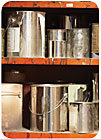
When most people think of workplaces that house hazardous materials, they are likely to list factories, refineries, nuclear plants and similar industrial settings. But even a small office, shop or other work facility might stock potentially dangerous chemicals, such as bleach and other cleaning products.
“Whether you’ve got a tanker-load or just a small bottleful, a hazardous material in the workplace needs to be considered as a potential health risk,†says Benjamin Mangan, president of MANCOMM, a national publishing company that develops and distributes regulatory compliance and safety training materials.
At every business level, big or small, OSHA regulations apply to the use of, and exposure to, the chemicals and other substances found there. Following these regulations is an essential directive for all companies, and not just because they should stay compliant with government regulations. They need to protect the health and well-being of their workers and communities.
“OSHA requires employers with hazardous chemicals in their workplaces to prepare and implement a written hazard communication program to identify dangerous substances present in the workplace,†says Mangan. “Employers must ensure that containers are labeled, employees are provided access to a material safety data sheet (MSDS) for each hazardous chemical, and training is provided for potentially exposed employees.â€
Small business basics
Employees need to know the identities and hazards of chemicals they are exposed to in the workplace. With this information, they can take part in their employer’s protective programs and also take steps to protect themselves.In many cases, the hazardous materials found in small businesses are cleaning chemicals. Usually they are consumer products — the same as those used in most households. These chemicals do not need to be included in a hazard communication program if they are used for the product’s intended purpose, duration and frequency.
If a chemical is used for other purposes — for example, if bleach is used full-strength instead of at a diluted strength given in the directions — it would need to be part of the hazard communication program. Other considerations include the length of time the product is used, as well as the frequency of its use. If it is used for a longer period and/or more frequently than it would be at home, it also needs to be part of hazard communication. The same applies if the business has more areas to clean than in a home.
Businesses should keep a list of the chemicals they use and make sure there are procedures for:
- Container labeling;
- How MSDSs will be received and kept;
- Making this information readily available to employees.
A solid understanding of the dangers of common chemicals and the requirements of the Hazard Communication Standard will help you uncover hidden hazards and protect your employees.